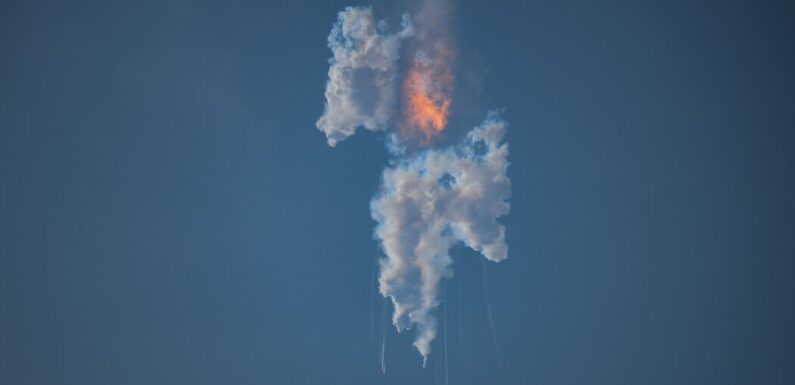
During its brief first flight more than a week ago, the gigantic Starship rocket made by SpaceX generated an unanticipated “rock tornado” at launch, and multiple engines failed as it headed upward before it somersaulted out of control.
Then, said Elon Musk, the company’s founder, in an update delivered during a Twitter audio chat on Saturday night, the end of the flight was tenser than it should have been. An automated self-destruct command did not immediately destroy Starship. Instead, 40 seconds passed before the rocket finally exploded.
Despite all that went wrong, Mr. Musk deemed the launch of Starship a success.
“Obviously not a complete success,” he said, “but still nonetheless successful.”
He said that the goal of the test flight was “to learn a lot, and we learned a lot,” and that more test flights were planned for this year.
The spacecraft, the most powerful ever launched, is central to SpaceX’s goals of getting humans to Mars, as well as to NASA’s plans to return astronauts to the moon by 2025 as part of the Artemis program.
Although the rocket did not make it to space, “the outcome was roughly what I expected, and maybe slightly exceeding my expectations,” Mr. Musk said, noting that it got “clear of the pad with minimal damage to the pad.”
At the same time, he acknowledged that the launch hurled debris across a wide area and generated clouds of dust, which reached a small town miles away from the launchpad at the southern tip of Texas.
During the discussion on Twitter, which lasted almost an hour, Mr. Musk answered abstruse technical questions and provided a detailed timeline of what went wrong during the four-minute flight.
Three of the 33 engines on the Starship’s booster stage were shut down before the rocket even left the launchpad.
“The system didn’t think they were healthy enough to bring them to full thrust,” Mr. Musk said, “so they were shut down.”
The loss of the three engines caused Starship to lean to the side as it headed upward. “We do not normally expect a lean,” Mr. Musk said. “It should be actually going straight up.”
Twenty-seven seconds after launch, something went wrong with one of the engines — “some kind of energetic event,” Mr. Musk said — and that damaged several other nearby engines.
“The rocket kept going, though,” Mr. Musk said. It was 85 seconds into the flight “where things really hit the fan,” Mr. Musk said, when the rocket lost its ability to steer its direction by pointing the engine nozzles.
From that point, the rocket started flying out of control and continued even after the termination command.
“It took way too long to rupture the tanks,” Mr. Musk said of the flight termination system, which is intended to destroy an out-of-control rocket. The delay did demonstrate the resilience of the rocket, which stayed intact as it tumbled.
“The vehicle’s structural margins appear to be better than we expected,” Mr. Musk said.
For the next launch, more explosives could be added to ensure that “the rocket explodes immediately if flight termination is necessary,” he said.
The other unexpected surprise was the shattering of concrete beneath the rocket at launch.
The thrust of 30 engines unexpectedly generated a “rock tornado” that scattered debris across hundreds of acres and generated a giant dust cloud.
“Basically a human-made sandstorm,” Mr. Musk said. “But we don’t want to do that again.”
Instead of the rocket’s 33 engines firing directly onto the concrete below the rocket at liftoff, a large water-cooled steel plate will be installed. Mr. Musk said the plate was not ready for last week’s launch.
He said the next rocket and repairs to the launchpad would be ready within six to eight weeks. However, the Federal Aviation Administration, which regulates rocket launches, is investigating the events of the first launch and will have to be satisfied with SpaceX’s adjustments and improvements before allowing another Starship flight.
The next launch would attempt to accomplish the goals of the first mission — for the Starship vehicle to successfully detach from the booster and reach space before circling most of the planet and landing in the waters off Hawaii.
Mr. Musk did not promise full success on the second try. He said he expected four or five more Starship launches this year. “We’ve probably got an 80 percent probability of reaching orbit this year,” Mr. Musk said. “I don’t want to tempt fate, but I think close to 100 percent chance of reaching orbit within 12 months.”
Mr. Musk said SpaceX was spending “$2 billion-ish” on Starship this year and would not need additional investments for development of the rocket.
One of the key uses of Starship will be as the lunar lander during NASA’s Artemis III mission, which is to take astronauts to the moon’s surface near the south pole. Mr. Musk confidently asserted that Starship would be ready before other components like the Space Launch System rocket being built by NASA. “We will not be a limiting factor at all,” he said.
He also emphasized the technical challenges that SpaceX is attempting to overcome in producing a giant spacecraft that can be rapidly reflown repeatedly, something more like a jetliner.
“This is certainly a candidate for hardest technical problem done by humans,” Mr. Musk said.
Source: Read Full Article